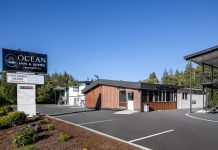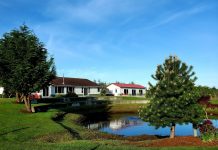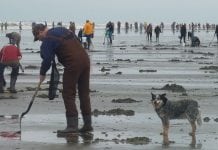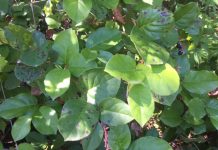By Douglas Scott
![]() The cities around Grays Harbor mirror the character of the people, especially in the face of adversity. This was evident during the first week of 2015, as torrents of rain fell from the sky, inundating streets, causing landslides and flooding around the region. The storm caused devastation around the region, with Aberdeen and Hoquiam seeming to take the brunt of the damage. While hillsides collapsed and floodwaters filled homes, the people of the twin cities of Grays Harbor did what they have done since the founding of the towns. Working together and smiling in relief that this was not worse, the citizens of our towns helped each other out and cleaned up after yet another storm.
The cities around Grays Harbor mirror the character of the people, especially in the face of adversity. This was evident during the first week of 2015, as torrents of rain fell from the sky, inundating streets, causing landslides and flooding around the region. The storm caused devastation around the region, with Aberdeen and Hoquiam seeming to take the brunt of the damage. While hillsides collapsed and floodwaters filled homes, the people of the twin cities of Grays Harbor did what they have done since the founding of the towns. Working together and smiling in relief that this was not worse, the citizens of our towns helped each other out and cleaned up after yet another storm.
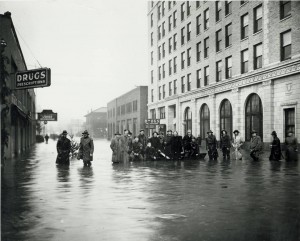
Aberdeen and Hoquiam are no stranger to floods and landslides in the region. Immediately after the first images of the storm damage was shared via social media and news outlets, John Larson of the Polson Museum in Hoquiam began looking through historic photographs of storm damage to find comparisons. Between trips helping community members trapped between landslides and surveying flood damage to the region, John was posting images from storms 75 years ago to the Polson Museum Facebook page. As each image was shared with the community, similar scenes were unfolding in real time along the towns’ streets and up on the bluffs.
On December 18, 1933, a storm slammed into the coast, blasting six inches of rain over 24 hours sideways through 90-mile-per-hour winds. Creeks and rivers, swollen from the deluge of water, met a high tide of 15.8 feet at the river mouthes and in the harbor. The waters converged, sending water everywhere. Just like the storm of January 5, 2015, roads and homes flooded along the lower lying areas.
“The flood waters this time were comparable to to the storm on December 18, 1933,” John Larson confirmed, continuing by explaining “the height of water was not as high this storm. All the flatlands in 1933 were covered in Hoquaim, as opposed to being mainly confined to the east side this last storm.”

Just like the 2015 storm, the 1933 storm was documented through photographs. The pictures allow us a glimpse at the character of our community 75 years ago. We see the same resiliency on our faces today. Taking boats out on streets, wading down the road in hip waders and posing for pictures in the flooded roads, the citizens of Aberdeen and Hoquiam in 1933 made the best out of a bad situation. Looking at the scenes that played out in 2015, the community still has the same spirit, with community members helping each other out with smiles on their faces and a pride for the character of the region.
The region has also been known for storms and flooding, a common occurrence during the winter months. The roads and walking areas of Aberdeen and Hoquiam were once made of planks, earning the nickname of Plank City. The planks, laid down to ease the muddiness of the region would float during heavy rains and floods, helping to cement the nickname into everyday use. Eventually, the planks were replaced, but the saturated ground has remained, as has the pride in the community for dealing with the rain.
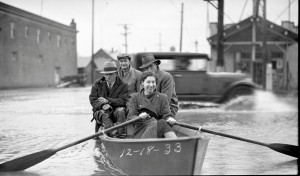
“The dampness that never goes away here is part of our DNA,” Larson explained referring to his neighbors. “There is definitely a pride about the rain here. The community created events like the Lions Club Rain Derby. We live in a wet place.”
Every storm that has hit the residents of Grays Harbor has only strengthened their resolve to live here and call this place home. We know we will get more storms in the future, and know that every hillside does have a potential to slide.
There are some steps you can take to prepare your family for a disaster. As Larson explains, “From the museum standpoint, I can recommend that people should be mindful of what you have laying on your floors. If you know a flood may occur, raise your appliances, put family photos up, wrap them in plastic and try to save precious things we possess.”
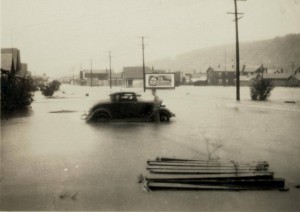
The storm of 2015 will be remembered for quite awhile. Not just because of images of hillsides collapsing, flooded homes and washed away roads, but for the way the community came together and helped out their neighbors. Within hours of sunrise on January 5, the community bonded together, helping hard hit areas like the incredible response for our neighbors of the Pacific Care Rehabilitation Center.
Stories of compassion and care are all around us, and just like the residents of our towns in 1933, we are stronger for this and gain even more hometown pride for the communities of Grays Harbor.
To learn more, visit the Polson Museum online or at 1611 Riverside Avenue in Hoquiam.



